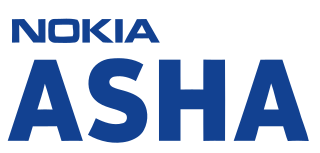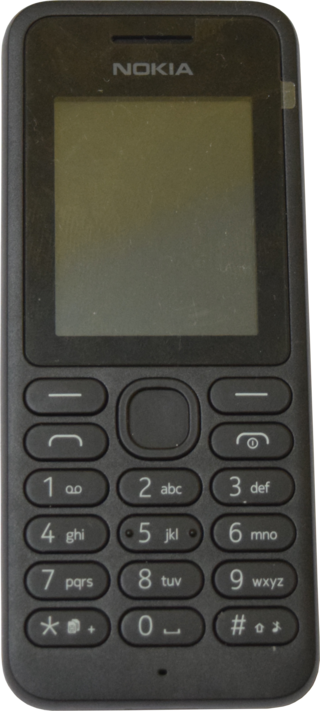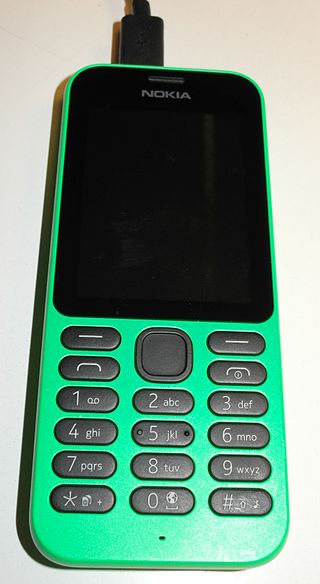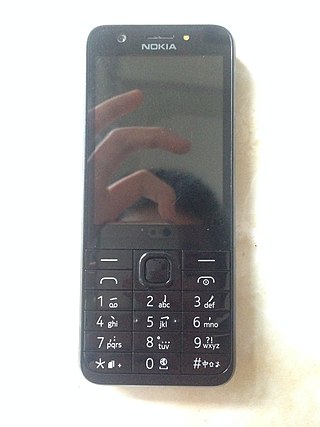
This is a comparison of the various internal components and features of many smartphones.

The Nokia 1680 classic is a Nokia dual-band GSM mobile phone. It has a VGA camera, speakerphone, multimedia playback, MMS messaging, web browser and e-mail client. Battery talk time is up to 7 hours and 40 minutes. Stand by time is 424 hours. Ringtones are Polyphonic 24 channels.
Nokia's strategic nomenclature can be traced back in 2005 when the Nseries line was launched, offering devices with flagship specifications and premium hardware at various price points. These devices were considered the "bread and butter" of the company and were often positioned to showcase their latest technologies. Thanks to the newfound consumer and enterprise interest in smartphones at the time, the company introduced four additional collections to diversify their product portfolio and meet demands in most market segments. These new phone series were named Eseries, targeting small business and enterprise customers; Xseries, providing consumer-grade multimedia-focused devices; Cseries, which Nokia used to target both the low-end and mid-range market segments; and Tseries, for devices exclusive to the Chinese market.

The Nokia Asha 200 & Nokia Asha 201 are budget-level additions to the Nokia Asha family released in Q4 2011. Both devices run the Nokia S40 mobile operating system. There is no direct predecessor of the phones, though the closest to it is the Nokia X2-01, which has similar features and a very similar user interface, as well as having better music capabilities. The Nokia C3 is also an indirect predecessor, also using similar features, though the C3 is a higher end device. The phones are successors to the Nokia X1-01, as they use the same bright colors and the same Dual SIM support for Nokia Asha 200.

The Nokia X1-01 is an ultra-basic phone manufactured by Nokia for users in developing countries. The phone was announced in May 2011 and released in June 2011. It is a dual SIM phone. The phone features 2G GSM mobile connectivity. However, it does not feature any internet connectivity, web browsing or social media capabilities, and apps cannot be installed by the user. It also does not have a camera, GPS, or Bluetooth hardware available.

The Nokia X family was a range of budget smartphones that was produced and marketed by Microsoft Mobile, originally introduced in February 2014 by Nokia. The smartphones run on the Nokia X platform, a Linux-based operating system which was a fork of Android. Nokia X is also known generally as the Nokia Normandy. It is regarded as Nokia's first Android device during the company's Microsoft partnership and was in the process of selling its mobile phone business to Microsoft, which eventually happened two months later.

The Nokia 101 is an ultra-basic dual-SIM mobile phone by Nokia. It is primarily geared for users in developing countries, or for people who need a simple communications device with FM radio and music playback.

The Nokia X2 is an entry-level smartphone which was announced and released by Microsoft Mobile on 24 June 2014. It is the successor of the Nokia X, being the first smartphone running version 2.0 of the Android-based Nokia X platform operating system. The Nokia X family of Android phones was discontinued on July 17, 2014.

Nokia 130 and Nokia 130 Dual SIM are Nokia-branded entry-level feature phones from HMD Global. Originally introduced in September 2014 by Microsoft Mobile, the 130 supports one Mini-SIM card and 130 Dual SIM supports two Mini-SIM cards. The cost will be equivalent of 19 Euros when bought unlocked and SIM-free. Its available colors are red, black, and white, depending on region and market.

The Nokia 215 and Nokia 215 Dual SIM are Nokia-branded dual-band GSM feature phones by Microsoft Mobile. The phones were released in the first quarter of 2015, in the Middle East, Africa, Asia, and Europe. They are available in black, white, and bright green.

The Nokia 105 (2015) and Nokia 105 Dual SIM (2015) are Nokia-branded feature phones originally developed by Microsoft Mobile. The phones were originally released on 3 June 2015, as a revival of the original Nokia 105, and sold again by HMD Global. The Nokia 105 (2015) has one SIM card slot, and the Nokia 105 Dual SIM (2015) with two slots. The selectable colours are black, white and cyan.
The following tables are comparisons of the specifications of Microsoft Lumia smartphones from within the same generation. Lumia devices were developed and sold by Nokia until the acquisition of its mobile phone division by Microsoft in early 2014. The Nokia brand continued to be used on new models until the release of the Microsoft Lumia 535 in November 2014.

The Nokia 230 and Nokia 230 Dual SIM are Nokia-branded feature phones originally developed by Microsoft Mobile. The phones were originally released in December 2015, and sold again by HMD Global in November 2018. The Nokia 230 has one SIM card slot, and the Nokia 230 Dual SIM with two slots. Initially, the phones were only released in black and white, but HMD would later add dark blue and light gray color options, after the release of Nokia 106 (2018) in November 2018.

Human Mobile Devices (HMD), formally HMD Global, is a Finnish independent mobile phone manufacturer. The company is owned by the Luxembourgish holding company Smart Connect GL. The company is made up of the mobile phone business that the Nokia Corporation sold to Microsoft in 2014, then bought back in 2016. HMD began marketing Nokia-branded smartphones and feature phones on 1 December 2016. The company has exclusive rights to the Nokia brand for mobile phones through a licensing agreement. The HMD brand was initially only used for corporate purposes and does not appear in advertising, whereas the name "Nokia Mobile" is used on social media. In January 2024, HMD rebranded to 'Human Mobile Devices' and will use its branding on future devices alongside that of Nokia.

Nokia 150 and Nokia 150 Dual SIM are Nokia-branded entry-level mobile phones from HMD Global. Originally introduced in December 2016, as the first Nokia-branded devices by HMD Global, the 150 supports one Mini-SIM card and 150 Dual SIM supports two Mini-SIM cards.

Nokia 130 (2017) is a Nokia-branded mobile phone developed by HMD Global. It was released on 17 July 2017.














